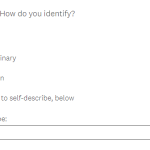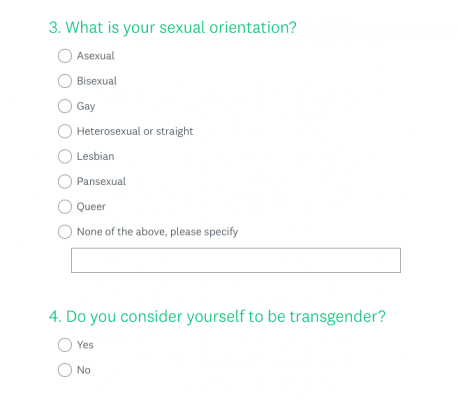According to our 2023 State of Surveys research, the way people ask about gender in surveys has drastically changed over the past decade. This isn’t just a sign of the times in the US and around the world—it’s also a great guide for how (and why!) to stay adaptable when asking questions about sexual orientation and gender identity. (Or as survey researchers refer to them, SOGI questions.)
Want to make sure you’re asking SOGI questions well? And that you’re approaching these potentially sensitive topics in a thoughtful and open-minded way? We can help. Keep reading for best practices and key research.
Surveys are becoming increasingly gender-inclusive
One of the most revealing findings from our 2023 State of Surveys report revolved around gender inclusivity. Ten years ago, more than 80% of survey questions only offered two gender answer options. In 2020, roughly 55% included three or more options. By 2022, the number of surveys offering three or more options increased to 64%. We predict that this percentage will grow in 2023 and beyond, as attitudes about gender identity continue to evolve.
A major takeaway here is that identity-based language is constantly changing, but making sure your surveys keep up isn’t hard. As the State of Surveys shows, it simply means staying flexible with your answer options and leaving room for people to choose how they want to identify.
SOGI questions may be less sensitive than you think
Worried that asking questions about sexual orientation or gender identity won’t go over well with your respondents? Here’s some research to help ease your fears. In 2017, researchers at the Census Bureau conducted an experiment to see whether respondents were more likely to skip SOGI questions than other typical demographic questions. They didn’t find evidence for that at all; in fact, significantly more people skipped the question about income compared to the question on sexual identity.
This holds up with more recent research, too. Current federal statistical surveys collecting SOGI data show that “respondents are unlikely to skip SOGI questions (low item nonresponse), especially compared to other sensitive data items.”
This research indicates that people are willing to answer personal SOGI questions—so let’s talk about how best to ask them.
7 tips for asking about sexual orientation and gender identity
Use inclusive language and survey design
The State of Surveys report found that 2021 was the first time that the number of gender survey questions that included “non-binary” as an answer option (17%) overtook the number that included “other” as an option (13%). While the frequency of the “other” options remained the same in 2022, “non-binary” continued to climb to 21%.
Labels matter, and good SOGI questions use inclusive language. They should also be designed to affirm someone’s identity rather than limit it. Let’s look at two versions of the same question:
- Please select your sexual orientation.
- Which of the following best represents your sexual orientation?
The first assumes that the answer is available to select. If a “fill in the blank” answer option isn’t available, this question could feel very restrictive—not a great experience for your respondents. In contrast, the second version of this question is basically asking the respondent how they most closely identify rather than making them select a definitive label. While we’d still recommend a “fill in the blank” answer option here, the wording of the question is more flexible than the first version and may lay the groundwork for a more inclusive survey experience.
Include self-describe answer options
We really can’t overstate the power of those “fill in the blank” answer options. If respondents don’t see an answer option that suits them, a comment field will empower them to describe their gender or sexual orientation in a way that’s authentic to them.

And the self-describe answers you receive may even give you new insight on what to ask in future surveys. Just be aware that some people may choose to identify using terms that were or are derogatory, as a way of reclaiming the meaning. Learn from those responses, but leave those terms to those community members.
Don’t combine sexual orientation and gender identity questions
For many years, the Gallup tracking survey asked this yes/no question: “Do you personally identify as lesbian, gay, bisexual, or transgender?” While this may have provided a broad estimate of LGBTQ+ individuals, it systematically overlooked the people who identified as both straight and transgender.
It’s important to avoid asking about sexual orientation and gender identity within a single question—this would be considered a double-barreled question and it’s a big survey no-no. Not only is it entirely possible that these identities are completely unrelated, but you risk muddying your data and making respondents feel misgendered or disrespected. For the Gallup survey question, the better approach would be to separate out the question on transgender identity like this:

Use skip logic to tailor the survey experience
When building an inclusive survey, skip logic can be an especially helpful tool. Let’s say, for instance, that a survey asks respondents to specify their gender identity. If they select “non-binary,” and are then asked something specifically about male or female identity, they might feel ignored or unwelcome. With skip logic, you can send respondents past any irrelevant questions and create a more personalized survey experience all around.
Include context when asking about gender and sexual identity
A little context can go a long way with SOGI questions. Try starting any questions about identity with a phrase such as “For demographic purposes…” and be upfront about the goals of your survey. Are you an HR director looking to uncover whether LGBTQ+ employees need more support? Are you conducting market research to better understand your brand’s audience? When you explain why you’re asking a SOGI question, it can help reassure respondents and boost your response rate.
Explain how data will be protected
Speaking of context, it’s always a good idea to be transparent about how SOGI data will be protected. Even the recent Federal Evidence Agenda on LGBTQI+ Equity included guidelines to safeguard individual privacy in SOGI data collection.
If you’ve built an anonymous survey, say so! (Your survey introduction is a great opportunity to do this.) This will help your respondents feel confident that their answers will not be used to identify them or in any other way that might harm them, such as “outing” them.
Recognize how personally identifiable information may affect other answers
Let’s say a company is creating an anonymous employee engagement survey. If there’s only one openly transgender sales rep at the organization, that person may feel that by answering a gender identity question, they are exposing themselves and their “anonymous” survey responses.
One way to avoid this is by putting yourself in the shoes of the survey respondent, then considering if any of the questions may potentially identify them. A simple fix might be to include a “Prefer not to say” answer option or make certain questions optional. But no matter what, you should take some time to recognize the ways that potentially identifiable information could impact your results and the respondent experience.
When should you not ask SOGI questions?
So we’ve just made a fine case for asking about sexual orientation and gender identity and given you tips to do it well. But here’s the thing: There might still be a valid reason for not asking a SOGI question.
These questions are very personal and if you aren’t planning on actually using the data, you can’t really justify asking the question. This is true of every question that you include in a survey, but it’s particularly important for sensitive demographic items. The Human Rights Campaign has more advice on when and how you should think about LGBTQ+ demographic questions, along with some examples.
Even if you have plans for the data, you should stop to consider whether you’ll be restricted by sample size issues or logistics. For example, we weight all of our SurveyMonkey polls to demographic characteristics from the US Census Bureau so that our results are representative of the national population. The Census Bureau’s respondents have to identify as either male or female, which affects our weighting when it comes to respondents’ gender. (We look forward to the day when the Census answer options are updated!) This goes to show that there are times when approaching gender in a binary way is unavoidable—but it’s best to be really mindful about it and limit when and how you do it.
If it’s important for your survey data, you shouldn’t shy away from asking SOGI questions. Remember, if you ever have doubts about how to approach these questions, the SurveyMonkey Question Bank is a great resource. It covers many tricky topics—including sexual orientation and gender identity, religion, race and ethnicity—and all questions are written and certified by our survey experts.




